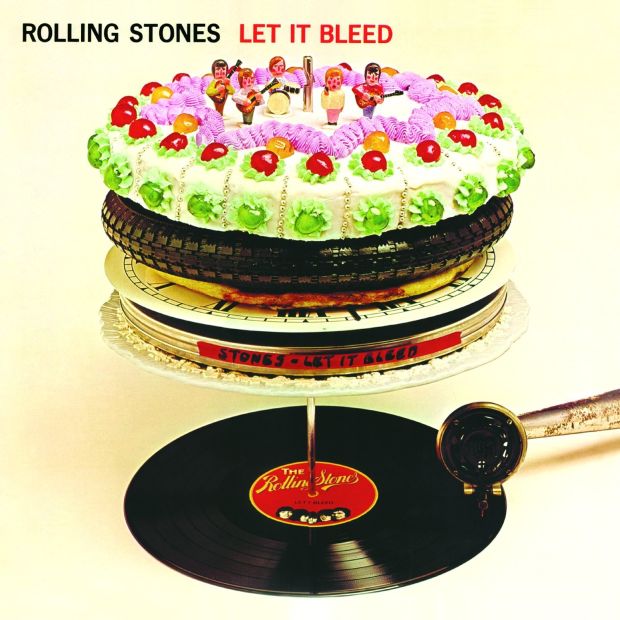In many ways it was a generation that had it coming. All that idealism and hedonism had created an unchecked portent for the demons to come roaring through. Nixon and Manson and the shadow of the Vietnam war were not so much the hangover from the hippy generation, as its natural conclusion. Once it was ascertained that the cultural revolution wasn't really going to change anything, the sobriety and the darkness kicked in.
In many ways though the nefarious elements and imagery of the late sixties was precisely the Stones' bag, at least until it affected them personally. Their dark and dangerous image was perfectly positioned to capture the mood of the times, even though in reality it was something of a cynical marketing exercise. For all their talk in fact of being the Beatles' dark flip side cousins the truth of the matter was that the Stones musical product was less about taking risks artistically and more about pandering to image. Circa 68, the Beatles had created three iconoclastic albums that had changed both their careers and the course of rock and roll forever. 'Rubber Soul', 'Sgt Pepper' and 'The Beatles' (or the White Album) didn't have to trade in on the age-old self destructive myth as their rivals did. They did it sonically, breathlessly taking in psychedelia among hundreds of different influences, creating the idea of the songwriter as a personal sage. In Lennon in particular, the Beatles didn't just have an exponent of that art either. They had someone who perfectly understood the cynical machinations of the times and wasn't afraid to call it. It gave the Beatles a texture that the public were able to tap into to. As other worldly as the Beatles were, they weren't really unattainable at all.
By comparison, the Stones reverential but slightly pastiche obsession of American blues music was nowhere near as ground breaking or revolutionary. It was quite lumpen really. White English boys singing about Satan and murder was little more than a vaudeville act in retrospect, but crucially in terms of social timing it created a moral panic both in the press and in households all over Britain in that period that was perfect in marketing the Stones as mad, bad and dangerous to know. It was essential in keeping them close to the blue centre light of teenage rebellion - without it and the Stones would have been just another talented rock and roll, rhythm and blues outfit - musically adept but not really appealing to a young audience who favoured the anti establishment over complicated chord sequences every time.
There was something else however that had glued their popularity from the start too and it wasn't particularly the songs of Jagger and Richards that had done it either. It was the sex appeal oozing from the silhouette of their real pin up and narcissistic bad boy Brian Jones. Jones was the ultimate in rock and roll libertines operating in the music at the time. He was like a character from a Blake poem, schooled in the poetic verse of a 'complete obliteration of the senses'. A real life Dorian Gray - success for Brian usually meant taking whatever drugs he could get hold of and living the life of an expressionist rebel. Temperance wasn't really his thing and ultimately he was doomed but for a long time within the Stones framework - Jones was the dark, brooding presence staring wildly out into the audience at Stones shows and who their teenage fans really gravitated towards before tragically and expectantly he sunk slowly headlong into the abyss.
Following his death in 1969 however, the small but significant hiring of his replacement would finally launch the Stones into their top gear. The appointment of guitarist Mick Taylor into their ranks was a master stroke that not even the band themselves could have imagined the potential of. Stepping into Jones' shoes for the final sessions for their 'Let it Bleed' album was perhaps slightly too early for the guitarists presence to be truly felt but following their completion, the resulting American tour certainly wasn't. Anyone witnessing those concerts must have been astonished to what they were witnessing. A loose and majestic Stones thrilling their stateside audiences with a mixture of energetic showmanship and sublime musicality. In particular the guitar interplay between Taylor and Richards was peerless. They had a way of playing their separate lines just behind or in front of each other which made the songs seem as though they were always on the verge of falling apart. With Jagger up front in full circus ringmaster mode too - it made the band seem as though every show they played might be their last. A mixture of fun and Faustian pact with an album to come that ironically had more than a touch of satanic majesty within its grooves.
Released on December 5th 1969, the resulting 'Let it Bleed' was a sorrowful, vengeful arrow head into the spirit of its times. As much as Hendrix's playing of the 'star spangled banner' at the Woodstock festival that year had seemed a political howl of unrest from a late sixties generation - 'Let it Bleed' really was it uncensored Polaroid. From the 'rape, murder. It's just a shot away,' - line from 'gimme shelter' - it was an album that teetered on the edge of violence whilst offering a perfect, Dante type glimpse into late sixties America. Free Love into sexual abandon. Peaceful protest into political violence, all framed by the musical druggy haze of that incredible music. Country and blues and soul whipped into a frenzy by a band at the top of their game. Sounding as though they were playing on the edges of Hell - when in reality they were about to step unwillingly into it.
Just 24 hours later in fact, at a free concert at Altamont - the Stones would pretty much taste Sulphur and experience first hand just how spiritually corrupt and nihilistic the counter culture ideal had become. Taking to the stage at midnight, the band stared out at the huge crowd as usual but rather than peace and love, all they saw was dilated pupils and the threat of violence staring back.
It was a mood that had been building all day. People out of their minds on drugs, overcrowding and security manned by the local Hells Angels fraternity - was a recipe for disaster and so it proved. Even before the Stones finished their first song in fact, violence was erupting in the first row. By the time they got to their third -'sympathy for the devil', a visibly shaken Mick Jagger cut the song short urging people to 'just cool out'. It was a plea that would fall on deaf ears however. Restarting their set, the Stones continued to play, but as they launched into 'under my thumb' another scuffle broke out that would be tragically significant. A young man called Meredith Hunter, who had been manhandled by a member of the Hells Angels security - decided to seek his own form of violent revenge. Rushing to the front of the crowd - he drew a revolver from his jacket pocket, but before he could he was tackled by a member of the Motorcycle fraternity who drew a knife quickly and ruthlessly before stabbing Meredith Hunter to death.
It would bring to an end what Rolling Stone magazine would later call 'the worst day in rock and roll history'. In many ways it should have destroyed the image of their musical namesakes too. The fact that it didn't pretty much summed up the fact that wherever the Stones went for a period in the late Sixties and just after, darkness and madness were their constant companions. The fact that they were pure survivors within that constant whirlpool - really gave them the true edge they'd been seeking all along.


